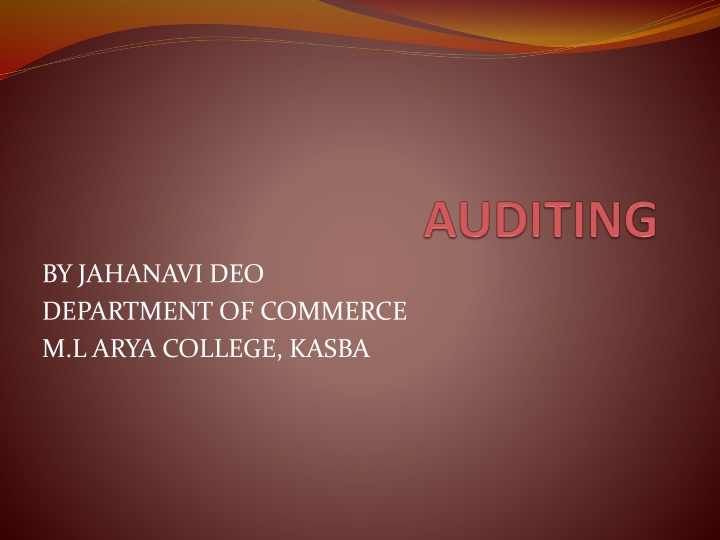
Internal Check in Accounting: Ensuring Efficiency and Compliance
Learn about internal check in accounting, a vital process for ensuring operational effectiveness, reliable financial reporting, and compliance with laws and regulations. Discover the features and objectives of internal check, such as preventing frauds and errors, determining responsibilities, and enhancing employee efficiency. Explore how this system aids in the quick preparation of final accounts and the division of work to maintain a rigorous accounting process.
Download Presentation

Please find below an Image/Link to download the presentation.
The content on the website is provided AS IS for your information and personal use only. It may not be sold, licensed, or shared on other websites without obtaining consent from the author. If you encounter any issues during the download, it is possible that the publisher has removed the file from their server.
You are allowed to download the files provided on this website for personal or commercial use, subject to the condition that they are used lawfully. All files are the property of their respective owners.
The content on the website is provided AS IS for your information and personal use only. It may not be sold, licensed, or shared on other websites without obtaining consent from the author.
E N D
Presentation Transcript
BY JAHANAVI DEO DEPARTMENT OF COMMERCE M.L ARYA COLLEGE, KASBA
Internal check Internal control, as defined by accounting and auditing, is a process for assuring of an organization's objectives in operational effectiveness and efficiency, reliable financial reporting, and compliance with laws, regulations and policies. A broad concept, internal control involves everything that controls risks to an organization.
Features Or Elements of Internal Check This technique is an integrate part of the complete system of internal control. This technique is related to the division of work among the people maintaining the accounts. In this technique, no single employee records any transaction from the beginning to the end. In this technique, the work done by every employee is examined independently by another employee.
In this technique, the work done by one employee is complementary to the work done by another employee. The aim of this technique is to develop an automatic system for detection of frauds and errors. In this technique, the work of book-keeping and accountancy is mechanised to the maximum possible extent.
(1) To prevent frauds and errors: The main objective of internal check is to establish a system which makes fraud impossible or very difficult to commit and hence employees are dissuaded against committing frauds. In the same manner the prevention of errors is also one of its objectives since in this technique there is provision for compulsory examination of work done by one employee by another.
(2) Determination of responsibility: The determination of responsibilities of employees is also one of the objectives of internal check. In this system work is divided in such a manner so that in case of frauds and errors the related officers can be held responsible. (3) To prevent omissions in accounting: The aim of this system is to bring about discipline in accounting so that no transaction is omitted from being recorded in the books of accounts.
(4) To increase the efficiency of employees: The aim of the internal check system is to divide the work into various parts and assigning it to those employees who are efficient in doing such work. In this manner, this system is also adopted in order to increase the efficiency of employees. (5) Quick preparation of final accounts: The aim of this technique to prepare an organisation structure of the accounting department in such a way that the accounting work can be done in an efficient and error free manner, and at the end of the financial year the final accounts can be prepared as quickly as possible.
(6) To case the audit work: The internal check system is also adopted in order to make the audit work easier. In organisations where this system is implemented the auditor can resort to test checking in his examination.
